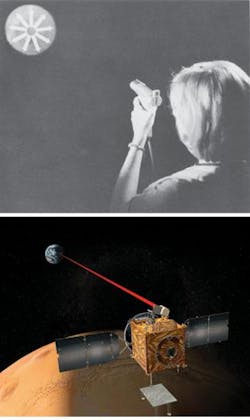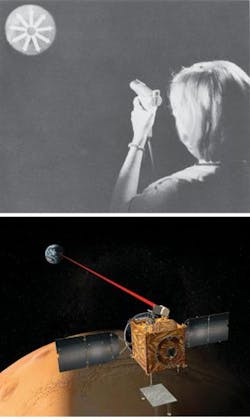Mars link: An old idea comes of age
Free-space communication with light can be as simple as the “Photophone,” invented by Alexander Graham Bell in 1881, in which a vibrating mirror modulates a beam of sunlight, which then falls upon a photodetector a short distance away. Though uncomplicated, with its electronics consisting of a photoconductive chunk of selenium, the Photophone was a remarkable invention. In the same way as the small steam engine devised by Heron in ancient Alexandria (one version of which was used to open a temple door), Bell’s Photophone presaged a major future technology, yet in its time was a minor novelty.
One reason the Photophone did not grow in use, as did the telephone, was its light source. As well as being at the whim of weather, sunlight-though one of the most directional light sources available at the time-diverged too much to be useful over long distances. In addition, its extremely broadband nature prevented the use of optical filters at the receiver to block a portion of the ambient light. (Another possible directional source-the carbon-arc electric lamp-was not only broadband and divergent, but high-maintenance and inefficient as well.)
But laser light, with its high directionality, brought free-space communications into the practical world. For this use, the laser was first applied as a simple replacement for the Photophone’s sunlight-as in the very first issue of Laser Focus, which described how an audio signal was sent across a room. “A self-contained, six-inch-long, pistol-shaped GaAs laser transmitter weighing only 12 ounces was recently demonstrated by scientists from IBM’s Federal Systems Division at the annual convention of the association of the U.S. Army held in Washington, D.C., late last year,” reads the article from the Jan. 1, 1965, issue. The article notes that IBM had first publicly demonstrated the transmission of audio via injection-laser light on May 21, 1963.
The 900-nm-emitting laser diode (operating at room temperature, thankfully) ran on 1.5 W of power and was modulated at anywhere from 4 to 20 kHz, although the audio signal included only frequencies between 0.3 and 3 Hz-a range comparable to that of a somewhat poor-sounding telephone. As with Bell’s Photophone, the demonstration consisted of sending a light beam across a room (see figure).
But engineers from PerkinElmer’s Electro-Optical Division (Norwalk, CT) achieved a far more impressive transmission distance on July 14, 1965, when they sent an audio signal 10 miles on a He-Ne laser beam. The laser link transmitted a discussion sponsored by the Springfield, MA, Museum of Science, in which scientists from the Jet Propulsion Laboratory (JPL; Pasadena, CA) gave a commentary on the fly-by encounter of the Mariner 4 spacecraft with Mars. The signal was sent from the museum’s rooftop to a receiver on a distant hilltop.
“A heavy fog accumulated in the evening-when the test was scheduled-which produced some scintillations; however, the condition cleared up later on,” reads the Aug. 1, 1965, Laser Focus article on the achievement. “The beam was shot very close over the ground, just skimming buildings whose radiant heat produced atmospheric disturbances. PerkinElmer engineers noted that the turbulence of the atmosphere in the path of the beam was about equal to the light-path disturbances that might be encountered during a laser voice transmission from the Earth to the Moon.” In the days of Mercury, Gemini, and Apollo, analog voice transmission was still key; perhaps the resulting device could be called the Astro-Photophone.
Seeing the future
But scientists already had far more ambitious goals in mind-as revealed in the very next (Aug. 15, 1965) issue of Laser Focus. In it, a team from RCA’s Astro-Electronics division (Princeton, NJ) called for extensive laser development to provide communications for a manned Mars mission in 1980-and this was no simple audio transmission they wanted. “Estimates by the RCA team indicate that data-communication rates for a Mars mission would have to be 10 million bits per second-a figure well above that currently achievable with microwave technology. These men, as well as some prominent space authorities, have expressed the opinion that even the earliest Mars flights will require wideband communications between spacecraft of the type offered by laser systems.”
Although 1980 came and went with no manned Mars mission, interplanetary laser communication leapt toward reality in 1995 when a bidirectional laser link was established between Earth and a geosynchronous satellite. The link, established from JPL’s Table Mountain facility (Wrightwood, CA) to the 35,000-km-high ETS-6 spacecraft between 1995 and 1998, conducted data to and from the satellite at rates up to 1 Mbit/s. The laser emitted a mere 13 mW-sufficient for near-Earth communication, but far too feeble for communication between planets.
The idea of sending data to and from Mars, however, is alive and well. In fact, scientists from NASA, JPL, and the Massachusetts Institute of Technology (Cambridge, MA) are working on the Mars Laser Communication Demonstration, which is slated to fly on the Mars Telecommunications Orbiter spacecraft to be launched in 2009; the link will be tested in 2010. The intent is to boost the maximum data rate between Earth and Mars from its current 1 Mbit/s for radio communication to at least 10 Mbit/s (precisely the rate mentioned by the prophesizing RCA scientists), and perhaps to as much as 100 Mbit/s.
The laser itself must have a multikilowatt peak power and will be a diode-pumped solid-state laser emitting around 1 μm. Extreme light weight and high reliability will be essential. Pointing requirements will be tight (about 0.2 μrad); from Mars to Earth, the laser beam will expand to only an eighteenth of the Earth’s diameter. Even so, the beam will be very dilute when it arrives-the receiving telescopes on Earth will need apertures of at least 10 m to collect a strong enough signal.❏

